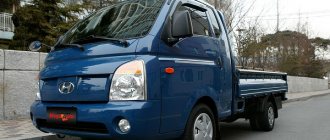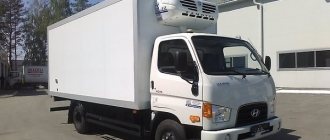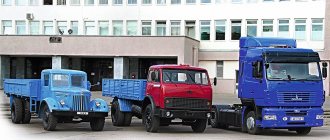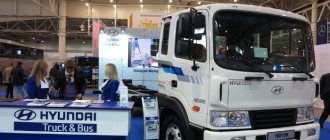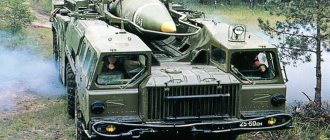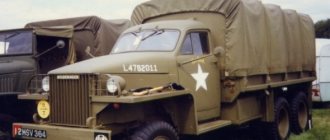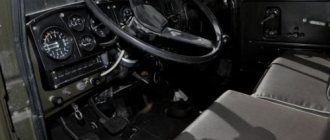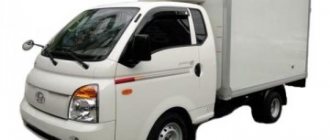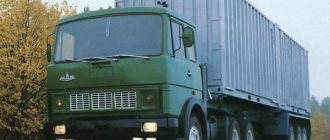Model history and purpose
Hyundai Porter has been produced since 1977. Initially, the model was intended for the domestic market and was not exported. The HD1000 model was produced in 2 modifications (minibus and truck). The debut Hyundai Porter was a copy of the Mitsubishi L300 (Delica) and was produced under license purchased from a Japanese company. The release of the first generation was completed 4 years after its appearance. The vehicle was positioned as a small commercial vehicle with a load capacity of 950 kg, intended for transporting a variety of cargo on small streets with dense traffic.
Production of the second generation Hyundai Porter did not begin immediately. The Korean auto giant was working on improvements for the truck; rebranding happened only in 1986. However, the model again did not become independent. Like its predecessor, it was produced under a license purchased from a Japanese brand, and was an analogue of the Mitsubishi L300 (Delica), copying its more famous “brother”. Initially, the second Hyundai Porter was produced in 2 modifications (minibus and truck), but then versions with an extended wheelbase and a double operator’s cab appeared. The model was removed from the production line in 1995. It was not possible to buy the second generation in Russia.
In 1996, the third generation of the truck debuted, officially called the Hyundai Porter. Its production continues in some countries to this day. The car was strikingly different from its predecessor and became a completely independent product of the Korean brand. The steering mechanism in the Hyundai Porter was migrated from the Hyundai Sonata, and the dashboard was from the Hyundai Grace.
A special feature of the model was the ability to assemble it like a construction set. A variety of bodies and equipment were installed on the chassis. In this case, the panels of the operator's cab were carefully adjusted, and there were no gaps. The rounded shapes added aerodynamics to the truck. The appearance of the third Hyundai Porter turned out to be very memorable. The voluminous operator's cabin, slightly protruding bumper and large round headlights made the car look like a “tadpole”. Separate elements made it possible to replace parts by part, which significantly reduced repair costs. The base model came in 2- and 4-door truck and 3- and 4-door van versions. In addition to the modification with a load capacity of 950 kg, there was a variation with a load capacity of 1200 kg.
The third generation Hyundai Porter was supplied to the Russian market, where it was very popular. In 2005, TagAZ and Hyundai agreed to cooperate, and production of the truck opened at a domestic plant. A year later, the model received the title of “Best Commercial Truck” in Russia. The domestic variation of the Hyundai Porter was developed taking into account harsh climatic and road conditions. The car was equipped with a reinforced suspension, a galvanized body with anti-corrosion treatment and increased ground clearance. The engine used was a 2.5-liter diesel engine.
Since 2005, production of the fourth generation Hyundai Porter began in South Korea, receiving the index II. The novelty immediately attracted the interest of organizations involved in freight transportation. The body design has become more dynamic due to the replacement of rectangular headlights with round ones, the appearance of smoothed contours and an enlarged windshield. In terms of equipment and finishing, the fourth generation Hyundai Porter resembled passenger cars and was distinguished by the significant quality of fit and assembly of elements.
The car's engine range has been revised. It includes turbocharged 2.5-liter diesel units and a 2.4-liter gasoline engine that meet the requirements of Euro 3, Euro 4 and Euro 5. The list of additional options offered by the manufacturer has expanded. Hyundai Porter could be equipped with foglights, central locking, heated mirrors and full power accessories. The model was produced with a single and double operator's cabin. The car began to be delivered to the Russian market only in 2012.
The compact truck gained great popularity among domestic consumers and became the main foreign competitor to the Gazelle. The ability to use on busy streets and high build quality have become the main advantages of the model. These qualities forced many to choose in her favor. Hyundai Porter was used for transportation on intercity and intracity routes. The presence of many specialized modifications (manipulator, lift, isothermal van, emergency vehicle and others) made the scope of the model very wide. At the same time, the car showed itself everywhere as a reliable partner, capable of performing the most complex tasks.
Specifications
Dimensions (third generation - Hyundai Porter I):
- length – 4750 mm;
- width – 1690 mm;
- height – 1930 mm;
- wheelbase – 1380 mm;
- ground clearance - 185 mm;
- front track – 1455 mm;
- rear track – 1380 mm.
Body dimensions:
- length – 2785 mm;
- width – 1600 mm;
- height – 355 mm.
The curb weight of the car is 1666 kg, the total weight is up to 2600 kg. The load capacity of the basic version is 950 kg, the extended version is 1250 kg.
Dynamic indicators:
- maximum speed – 160 km/h (in the absence of a limiter);
- acceleration to 100 km/h – 16.3 seconds.
Fuel consumption and wheel characteristics
The average fuel consumption of the Hyundai Porter in the combined cycle is 10.2 l/100 km. Fuel tank capacity – 6 l.
Tire size – 185 R14.
Additional characteristics of the refrigerated cargo truck:
Brand and size of tires on 1st axle: Tigar 195 70R16c remaining tire tread height - 50% Brand and size of tires on 2nd axle: TIANFU 155 R12c remaining tire tread height - 30%
Spare wheel — Tigar 195 70R16c remaining tire tread height — 50% Spare wheel — TIANFU 155 R12c remaining tire tread height — 50%
ABS+ASR | Power steering | Radio | Fog lights | Leather deputy seat upholstery| Vacuum brake booster | Power windows | Central lock | Interior heater | Cabin spoiler | Air conditioning working together with HOU | User manual
Engine
The Hyundai Porter line of power units consists of 3 diesel and 1 gasoline engines. The petrol variation has 2 valves per cylinder (4 cylinders in total). 2.4-liter engine with a power of 110 hp. was produced with a carburetor (modifications before 1994) and distributed injection (versions after 1994).
There were several diesel engines:
- 2.5-liter naturally aspirated engine (rated power – 75 hp);
- 2.6-liter naturally aspirated unit (rated power - 60 hp). Modifications with it were available exclusively on the Korean market and were not exported.
- 2.5-liter D4BF turbocharged engine (rated power - 80 hp). This power plant was used in models that were produced at the Russian TagAZ plant, therefore modifications with it were the most common on the domestic market. The 8-valve overhead camshaft unit complied with Euro 3 environmental standards. The basis for it was the Mitsubishi 4D56 engine, which has proven itself in other cars. The D4BF engine was distinguished by throttle response, efficiency and excellent traction. The unit had an in-line arrangement of cylinders (4 pieces) and a maximum torque of 200 Nm.
Device
Hyundai Porter was endowed with a simple design, the basis of which was a high-strength frame. The steel used in the manufacture of the frame was of high quality, which guaranteed trouble-free operation for a long period of time. The design of the truck was developed to ensure movement in city conditions with constant maneuvering. Small dimensions and excellent visibility made driving easier.
Starting from the first export generation, the Hyundai Porter was equipped with a sophisticated suspension, additionally equipped with anti-roll bars. They were installed on the front and rear suspension. To improve stability and load capacity, the rear suspension was made spring-dependent with hydraulic telescopic shock absorbers. The front suspension was torsion bar, independent with hydraulic telescopic shock absorbers, anti-roll bar and wishbones.
The Hyundai Porter I (third generation) was equipped with a dual-circuit hydraulic brake system with a vacuum booster and diagonally divided into circuits. Ventilated disc brakes were used at the front and drum brakes at the rear.
The ABS system on the Hyundai Porter I was installed as an additional option. The steering was built as a “rack and pinion” type, the drive was equipped with a hydraulic booster (initially power steering was again an option).
A variety of bodies were installed on the Hyundai Porter: flatbed platform, manipulator, platform with an awning, manufactured goods van, emergency service van, mini-lift, isothermal van and others. There were 1.5- and 2-cabin versions. The Russian plant produced exclusively 1-cabin modifications. the considerable loading height facilitated the process of loading (unloading) goods.
The operator's cabin of the car was quite comfortable. The 3-spoke steering column provided a full view of the instrument cluster. There were 3 seats with seat belts in the cabin, but only 2 people could travel comfortably in the car. The driver's seat was adjustable in terms of tilt and horizontal plane (adjustable lumbar support was installed in the maximum configuration). The basic set of dials was not modern (no newfangled displays or computers), but it was informative and convenient. Among the nice additions was the illuminated ignition switch. The quality of sound insulation and interior assembly was at a high level. The operator's cabin itself was located above the engine on a rigid frame. Access to the engine was provided from it.
Hyundai Porter II (fourth generation) debuted on the market in 2005. In Russia, this generation is less common. The basis for the car was a frame structure consisting of several sections. The layout of the truck remains the same - short wheelbase and front engine. Despite the external similarity, the new product has a number of significant differences in comparison with its predecessor. First of all, the dimensions of the car have increased (length - up to 5120 mm, width - up to 1740). Compactness and maneuverability have been preserved. The design of the operator's cabin has again changed. Instead of lonely round headlights, block headlights appeared, giving the car a stylish look. A bumper with built-in fog lights made the Hyundai Porter more expressive. The onboard versions now have a side step, making the work process easier. In the basic configuration, the Hyundai Porter was equipped with ABS, which improved the car's handling.
A spoiler was installed on top of the operator's cabin to reduce drag. The car is equipped with air conditioning and electric windows. One interesting innovation appeared inside - the middle seat swiveled, turning into a table. Increased attention has been paid to the modernization of the operator's cabin. The car was offered in versions with a 3-seater operator's cabin and a sleeping bag and a 6-seater operator's cabin. By increasing the area of the side windows and triplex glass, visibility has improved, and the side mirrors are electrically driven. The steering column had several adjustments, the quality of the seats improved, seat heating and a tachometer appeared. For a variety of small items, a 2-section glove compartment and a specialized compartment were installed in the cabin. Already in the basic version, the model was equipped with fabric upholstery and a radio with CD. Thanks to this, driving comfort has increased. The car (in some versions) has become suitable for use on intercity and interregional routes.
Korean specialists have also improved other systems. The brake system was modernized, and the brake pedal received a short stroke. A system for regulating braking forces has appeared. A clutch booster was installed on the car. In addition to the 5-speed manual transmission, the new product was equipped with a 4-speed automatic transmission. The vehicle's carrying capacity remains the same.
Pros of Hyundai Porter:
- considerable carrying capacity allows movement in areas where large trucks are prohibited;
- low fuel consumption;
- huge resource of work and adaptation to Russian conditions;
- the ability to drive with category “B” license;
- convenient loading height and large capacity.
Cons of Hyundai Porter:
- inconvenient location of the battery (significant risk of theft);
- poor rear visibility.
Hyundai Porter will be an excellent purchase for small and medium-sized businesses operating in the field of cargo transportation, and will allow you to deliver cargo with minimal time and money.
Design
This type of car is based on the multi-purpose small-tonnage car Hyundai Porter 2. It has a classic frame design with a driven rear axle.
The cabin of this car is small, designed for three people, equipped with a large amount of equipment that provides comfort, including even a rear view camera for the convenience of transporting cargo.
The power plant is a 4-cylinder diesel engine, located in a hoodless space. It is equipped with a turbocharger to increase power. The gearbox of this car is manual, 5-speed.
Refrigerated van
The insulated van of the Hyundai Porter 2 has a frame made of transverse and longitudinal beams. The supporting structure is completely welded, but is attached to the car frame using a bolted connection.
The van floor is three-layer. The heat-insulating substance is polystyrene foam with a thickness of 80 mm, placed between sheets of plywood. The floor is protected from damage by sheets of steel with welded seams to ensure sealing.
The walls, door ceiling and rear wall are also three-layer, with a layer of polystyrene foam 60 mm thick. On both sides their surface is covered with plastic with fiberglass reinforcement. All seams and joints of the van are properly taped and treated with sealant.
The rear doors are double, hinged, three-layer with an insulating layer thickness of 60 mm. There is one side door, also hinged and with the same layer of insulation. All doors are equipped with seals and internal locks.
The temperature inside the van is maintained by a refrigeration unit similar to an air conditioner. Its outer part is located above the cabin, but to improve the streamlining of the car, it is covered with a spoiler. The interior of the refrigeration unit is located on the rear wall of the van under the ceiling.
